Italy
Civita di Bagnoregio
The Cultural Landscape of Civita di Bagnoregio is an example of an ancient village founded in a precarious location, atop a high tuff peak on the border of the ancient Volsini volcano. Originally settled by the Etruscans or Villanovians over 2500 years ago, the village largely dates to the medieval period. Set in a fragile and unstable environment, there is clear evidence of the natural degradation of the cliff over the centuries and human attempts to halt it.
Site Info
Official Information
- Full Name
- The Cultural Landscape of Civita di Bagnoregio (ID: 6182)
- Country
- Italy
- Status
-
On tentative list 2017
Site history
History of Civita di Bagnoregio
- 2023: Requested by State Party to not be examined
- .
- 2017: Added to Tentative List
- Added to tentative list
- Type
- Cultural
- Criteria
Links
- Official
-
- ilpaesaggioculturaledicivitadibagnoregio.it — Official website
All Links
Official Website
- ilpaesaggioculturaledicivitadibagnoregio.it — Official website
Community Information
- Community Category
- Cultural Landscape: Relict
Travel Information
Recent Connections
News
No news.
Community Reviews
Show full reviewsJakob F.
The Cultural Landscape of Civita di Bagnoregio by Jakob Frenzel
Civita di Bagnoregio (On tentative list)

March 2023 - Bagnoregio was on our way south. Not only a promising tentative site but also nominated for this year, we definitely put it on our itinerary. We arrived in the evening and parked our camper on the Public parking lot. Next morning before the tourist masses would appear we walked our way to the Bridge, had the best Cappuccino of the whole trip in a random Café on the main street to Civita.
Already in the morning we had to pay 5€ to climb up the steep bridge to the town entrance. The town was completely deserted at first, except for a few cats enjoying the sunshine. The Restaurants and souvenir Shops were still to be opened. We enjoyed the scenery visible from the few viewpoints, which is part of the nomination, as well as the many planters embellishing the facades.
There is many more of such wonderful villages. But taking into account the beautiful surrounding, it would not be mistaken on the WHS list.
Keep reading 0 comments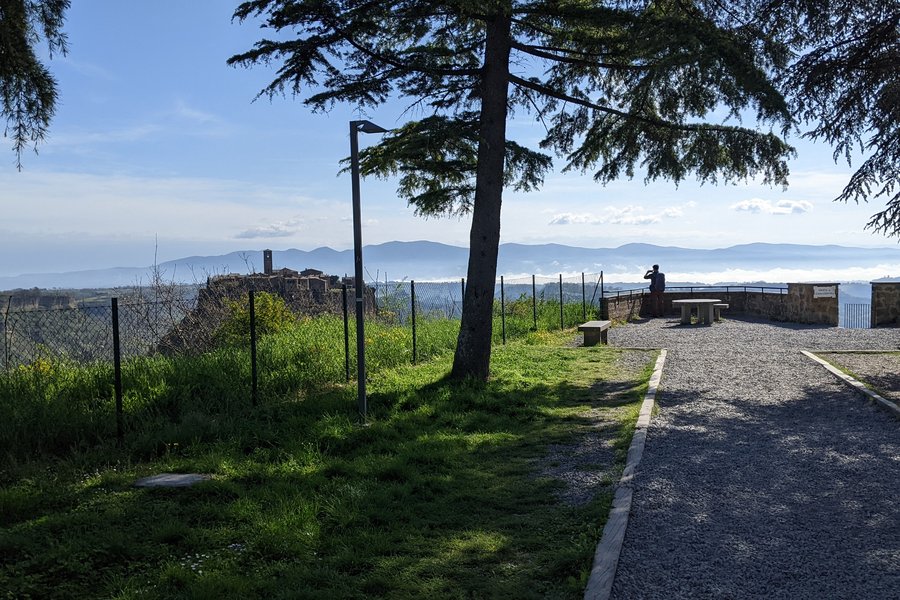
We were fortunate to take the morning bus from Viterbo to Bagnoregio, as the landscape was still blanketed in slight fog, adding a mythical feel to the stunning view of Civita di Bagnoregio from the viewpoint. Also, we managed to arrive before the big tour groups from Rome that would later crowd the town.
After taking plenty of pictures, we climbed the walkway, paying the 5 EUR entrance fee to support the preservation efforts of the crumbling hill. Although I would have preferred a proper ticket instead of a thermoprinted one, it was a small price to pay.
The town itself was rather compact, and we explored the alleys, took pictures from the walls overlooking the volcanic landscape, had some ice cream, and returned to Bagnoregio. On our way back, we noticed the increasing crowds of tourists arriving, making us grateful for our earlier arrival. I should note that my travel companion struggled with the climb up to the town due to a fear of heights, but we managed to get up and down.
OUV
Before I present my case against inscribing Civita di Bagnoregio as a World Heritage site, I want to acknowledge that its stunning scenery and popularity with international tourists make it highly likely to be inscribed. So, please don't change your travel plans based on my argument.
That said, I have two concerns about the site's Outstanding Universal Value (OUV), which should be considered when evaluating its candidacy. If these criteria were applied, Civita di Bagnoregio …
Keep reading 0 comments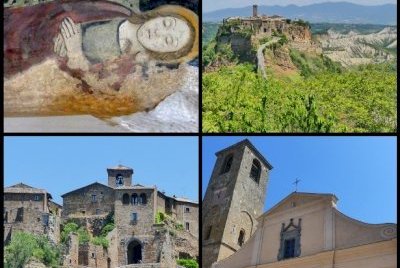
I visited this tWHS by car in 2022. The best light within the Civita is in the morning just after the morning dew and mist, while the best views from any viewpoint opposite the Civita are definitely in the afternoon with the sun shining from behind you. Parking near the small village before the parking proper is free while the parking lot (which looked quite unsafe when I visited since what looks like a large modern visitor centre is still under construction) costs 5 euro for a day ticket. You'll also have to pay a further 5 euros to cross the modern bridge and visit the Civita proper which further underlines the fact that the Civita is a "dying museum town".
The heart of the Civita is Piazza San Donato with the Church and Belfry dedicated to San Donato and a permeating smell of lavander from the local craft shops. It really looks like a typical Medieval film set with many rustic Medieval town houses, small pretty gardens, intricate Medieval porticoes and archways with Renaissance friezes, external stairways, and a few Etruscan, Roman and Longobard remains displayed in different small artisans' shops, restaurants and museums. There are a couple of worthwhile viewpoints of the surrounding environment and it is especially worth viewing the nearby sea of calanques which are quite similar to the Crete Senesi in Tuscany. After visiting the main church's interior to appreciate its frescoes, and after exploring most if not all of the small streets and …
Keep reading 0 comments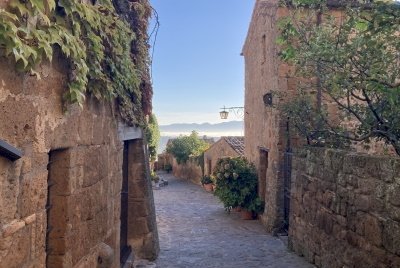
When my Art History friends decided to have our annual get-together in Rome, I immediately extended the trip with a day to include Civita di Bagnoregio. This was supposed to be Italy’s nomination candidate for 2022 (now postponed to 2023). I stayed overnight in the core zone, a spooky experience as the place gets deserted at night. I arrived at the footbridge only at 7.30 pm; most of the approach was barely lit and neither was the village as only 16 people permanently live there. No restaurants are open in the evenings (at least not in October) and the owners of my B&B had left me the key at a hiding place.
Still, the people at the ticketing kiosk collecting the 5 EUR entrance fee to the village were at their post in the evening. The introduction of this fee for the 1 million yearly tourists has been a blessing for both Civita’s and Bagnoregio’s inhabitants, as communal taxes have been abolished for them since.
I explored Civita the next morning - it takes half an hour at most. There is one main street, which you can follow further down a bit towards a cave. The cave was used for burials by the Etruscans, but after the large earthquake of 1695, it was turned into a Roman Catholic chapel. The views from the village towards the surrounding landscape are quite picturesque, but overall I found the town more suitable for a ‘’Most Beautiful villages” award than WH status. …
Keep reading 0 comments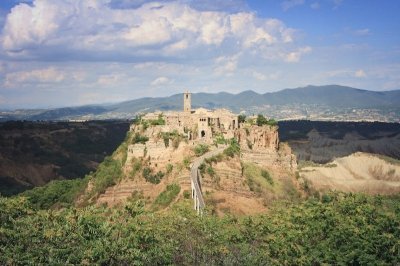
The Civita (old settlement core) of Bagnoregio is a small village built on top of a tuff peak that is slowly crumbling away, nicknaming it “the dying city”. The town can be reached on rural roads between Orvieto and Viterbo, You can access the Civita walking down and up from the new part of Bagnoregio. There is a car park close to the access and view point (best pictures from there) as well as restaurants and shops. Parking is more expensive than in the center, but the walk is too long from the next place you could park the car.
It feels a bit weird to me that you have to pay entrance to a village, where actual people (12 permanently) live, but I guess it helps to preserve the village.
The only bridge to access the Civita and the village itself are clearly not made for cars. But it’s Italy and of course they found a way to use vehicles anyway. There is are 2 or more tiny Red Cross cars driving on the bridge, being only able to pass by if pedestrians clutch themselves to the railing. Several motorbikes passed the bridge as well during our visit.
The village has no real highlights to offer, but is like a beautiful piece of art in total. We visited a tiny cave museum with Etruscan and Medieval remains for only 2 EUR per person. At the end of the village, there is a private garden that can …
Keep reading 0 comments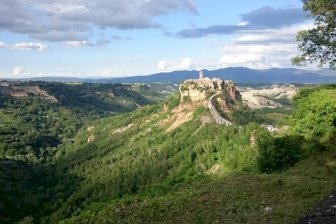
Updates September/2021: I am reading the nomination file and thinking intensively about the OUV justification. The town Bagnoregio, the hamlet Civita, and the surrounding Valle dei Calanchi (Badlands Valley) have been proposed as the core zone.
The text is rather confusing, the justification is full of flowery phrases not easily understandable for me. The new term "antifragility" as the main feature of Civita has been invented and proposed following the Italian tradition of artificial intellectual constructions (Bologna porticoes). It is argued that the place is permanently inhabited since Etruscan times, and now there are still around 10 residents. Without the human interventions Civita would be totally eroded as seen all around. I am wondering why the inhabitants are so stubborn, maybe the reason is a beauty of the place...
In the comparative analysis, places like Athos, Meteora, and other similar sites all over the world are mentioned. However, the highest frequency of the comparable places are in Italy: WHSs - Amalfi, Matera, Cinque Terre, Piedmont vineyards, Val d´Orcia, TWHSs - Volterra, Orvieto, and other sites - Pitigliano in Tuscia, or Aliano in Basilicata. I have to admit that Civita is kind of different when compared to above listed sites. The integrity and authenticity is indisputable. The Civita houses are built from the same tufa stones on which they stand, and there is no disturbing element. Even the concrete bridge from 1963, which is described in the justification in detail, is OK and can be taken as the important …
Keep reading 0 comments
